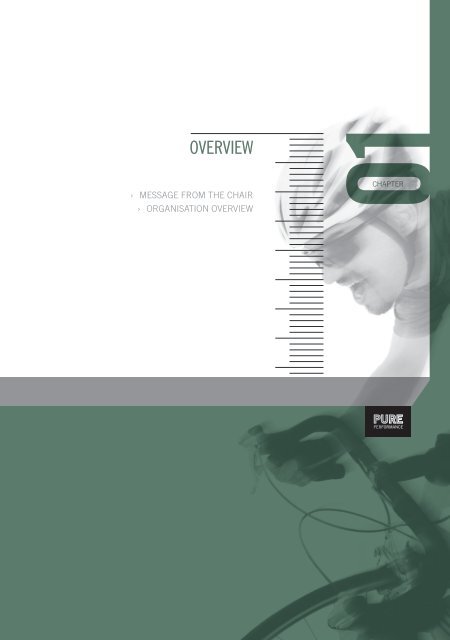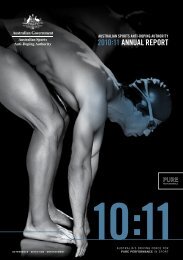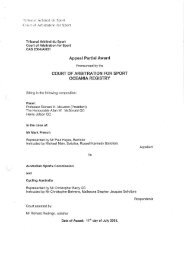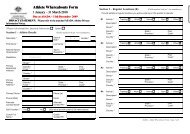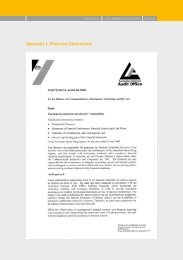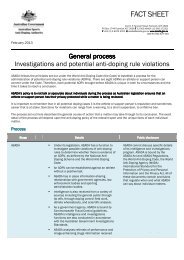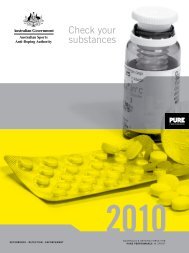Australian Sports Anti-Doping Authority :: 2006-07 Annual Report
Australian Sports Anti-Doping Authority :: 2006-07 Annual Report
Australian Sports Anti-Doping Authority :: 2006-07 Annual Report
You also want an ePaper? Increase the reach of your titles
YUMPU automatically turns print PDFs into web optimized ePapers that Google loves.
OVERVIEW<br />
›› Message from the Chair<br />
›› Organisation Overview<br />
01<br />
CHAPTER
2<br />
OVERVIEW ASADA <strong>Annual</strong> <strong>Report</strong> <strong>2006</strong>:<strong>07</strong><br />
Message from the Chair<br />
This annual report comes at the conclusion of the debut year for the <strong>Australian</strong> <strong>Sports</strong><br />
<strong>Anti</strong>-<strong>Doping</strong> <strong>Authority</strong> (ASADA). The <strong>Australian</strong> Government launched ASADA on<br />
14 March <strong>2006</strong> with a goal of making the ‘tough on drugs’ in sport message even<br />
tougher. ASADA has boosted Australia’s historical strengths in the areas of education and<br />
testing by the addition of a suite of new functions in a number of diverse areas. These<br />
include conducting investigations, presenting cases at sporting tribunals, recommending<br />
sanctions, and approving and monitoring sporting organisations’ anti-doping policies.<br />
Most importantly, ASADA has been empowered with the ability to share information with<br />
other <strong>Australian</strong> Government agencies (such as the <strong>Australian</strong> Customs Service, <strong>Australian</strong><br />
Federal Police and Therapeutic Goods Administration) to accelerate whole‐of‐government<br />
cooperation in the fight against doping in sport.<br />
Internationally, ASADA has been commended by the World <strong>Anti</strong>-<strong>Doping</strong> Agency, which<br />
said, ’Australia has taken this approach [of anti-doping] even further and developed<br />
a revolutionary model that solidifies cooperation between the anti-doping authority<br />
and other government agencies’ (WADA Play true magazine, Issue 1 20<strong>07</strong>, p8).<br />
ASADA is an innovative organisation with a vision for Pure Performance in sport,<br />
supported by a range of new powers. Our mission is to protect Australia’s sporting integrity<br />
through the elimination of doping.<br />
Throughout our debut year of operation, ASADA remained focused on building new<br />
capabilities required under our new legislation and delivering on our expanded range of<br />
outcomes across our frontline business units of Deterrence, Detection and Enforcement.<br />
Deterrence<br />
ASADA’s first goal is to deter athletes from involvement in doping, which is achieved<br />
by educating at-risk athletes. ASADA seeks to communicate the message of Pure<br />
Performance to athletes in a way that is relevant and inspiring.<br />
During the past year, ASADA’s commitment to innovative anti-doping education has<br />
been demonstrated by the piloting and rollout of the ASADA Pure Performance Outreach<br />
Program. The program, aimed at the elite athletes of tomorrow, is supported by a team<br />
of qualified ASADA educators. Designed to be informative, interactive and fun, the<br />
program was developed in close consultation with the World <strong>Anti</strong>-<strong>Doping</strong> Agency (WADA)<br />
and the <strong>Australian</strong> Olympic Committee. The program made its highly successful debut<br />
at the 20<strong>07</strong> World Olympic Youth Festival in Sydney, where the response from athletes<br />
was enthusiastic.
ASADA <strong>Annual</strong> <strong>Report</strong> <strong>2006</strong>:<strong>07</strong> OVERVIEW<br />
3<br />
Another key component of ASADA’s Education Service<br />
Charter was the development of a Pure Performance<br />
Athlete Workshop aimed at elite athletes in sports at<br />
greatest risk of doping. The workshop was trialled as<br />
part of an eight point anti-doping action plan for the<br />
sport of weightlifting, a sport determined to rebuild the<br />
confidence and trust of the <strong>Australian</strong> sporting public.<br />
ASADA also developed and piloted a Pure Performance<br />
Seminar to provide athletes and support personnel with<br />
quality anti-doping education. Seven pilot seminars were<br />
conducted during <strong>2006</strong>–<strong>07</strong> with the aim of informing<br />
participants about their anti-doping responsibilities and<br />
reducing the risk of athletes inadvertently doping.<br />
ASADA EXECUTIVE, KEVIN ISAACS<br />
ASSISTS AT OUTREACH<br />
PROGRAM<br />
ASADA’s revamped education program – targeted at both<br />
the stars of today and tomorrow – will be rolled out across urban and regional Australia<br />
in 20<strong>07</strong>–08. This will help communicate the message of Pure Performance to thousands<br />
of <strong>Australian</strong> athletes, their parents and other support personnel.<br />
In March 20<strong>07</strong> ASADA’s Deterrence team launched a dedicated Athlete Whereabouts<br />
Online System to make life easier for elite athletes who, under their sporting rules, must<br />
provide whereabouts information for No Advance Notice testing. Using state of the art<br />
technology, the portal was launched following extensive consultation with stakeholders.<br />
It now provides athletes with secure, online convenience, around the clock, for lodging<br />
and updating whereabouts information. Feedback has been positive regarding the new<br />
online system compared with the previous cumbersome paper and fax-based system.<br />
No Advance Notice testing of athletes is a requirement under the World <strong>Anti</strong>-<strong>Doping</strong> Code<br />
(the Code) to ensure the maximum chance of detecting possible doping.<br />
The activities of ASADA cannot take place without the support of our key domestic<br />
partners. During the year, 95 domestic sporting organisations signed letters accepting<br />
the jurisdiction of ASADA in anti-doping matters. With these letters of referral in place,<br />
all recognised national sporting organisations are fully compliant with respect to their<br />
anti‐doping policy obligations under the ASADA legislation. I would like to acknowledge<br />
the goodwill and cooperation ASADA received from all sporting organisations (NSOs)<br />
as we completed this process.<br />
Detection<br />
While we all hope that <strong>Australian</strong> athletes would not involve themselves in doping, it is<br />
imperative that ASADA builds robust systems to catch those who let themselves, their<br />
sport and their country down by doping.
4<br />
OVERVIEW ASADA <strong>Annual</strong> <strong>Report</strong> <strong>2006</strong>:<strong>07</strong><br />
ASADA has redefined detection in anti-doping by building a holistic capability integrating<br />
traditional testing with new powers of investigation that comply with the <strong>Australian</strong><br />
Government Investigations Standards. Combined with the new relationships ASADA has<br />
built in the past year with other government agencies such as the <strong>Australian</strong> Customs<br />
Service, ASADA has a detection capability greater than ever before.<br />
ASADA conducted 6,953 tests during the past year across 65 sports and 2,220 athletes.<br />
In March, ASADA conducted over 300 tests during two intensive weeks of competition<br />
at the Fédération Internationale de Natation (FINA) World Swimming Championships<br />
in Melbourne. Per capita, Australia has one of the largest testing programs in the world,<br />
which acts as a major deterrent to doping.<br />
During the year, ASADA completed the first of several investigations, examining allegations<br />
of doping in the sport of weightlifting. This investigation proved to be an early test of the<br />
organisation’s capabilities, as ASADA needed to work cooperatively with two state police<br />
forces and an international laboratory to fully examine the allegations.<br />
As a result of this groundbreaking investigation, five athletes and/or athlete support<br />
personnel from the sports of weightlifting and power lifting were placed on the Register<br />
of Findings (RoF) for a range of serious doping violations. These included use, possession,<br />
or trafficking of prohibited substances such as stimulants, steroids and human growth<br />
hormone (hGH). Sanctions applied to these offences have ranged from two years to<br />
lifetime bans from sporting competition.<br />
While testing can detect many forms of doping, it cannot detect serious violations such<br />
as possession and trafficking. To complement traditional testing, ASADA has a strong<br />
investigative capability that represents a new and powerful front in the fight against the<br />
most serious forms of doping in <strong>Australian</strong> sport.<br />
Enforcement<br />
ASADA’s enforcement activities represent another new function developed in the debut<br />
year of operations. Analysing case materials, preparing evidentiary briefs and arguing<br />
cases before the relevant sporting tribunal, the role of ASADA’s Enforcement unit is<br />
to apply the Code fairly and firmly when athletes or support personnel have violated<br />
anti‐doping rules.<br />
During the past year, 24 athletes and athlete support personnel were found to be in<br />
violation of Australia’s strict anti-doping rules. For the first time, application of ASADA’s<br />
new powers has seen athletes sanctioned for using substances that traditional testing<br />
cannot detect.
ASADA <strong>Annual</strong> <strong>Report</strong> <strong>2006</strong>:<strong>07</strong> OVERVIEW<br />
5<br />
The clear trend in anti-doping is the growing number of violations detected via<br />
investigations where evidence may be sourced from a variety of avenues including police<br />
or <strong>Australian</strong> Customs. Tribunal hearings of such matters are becoming increasingly<br />
complex, lengthy and expensive.<br />
Support<br />
During the <strong>2006</strong>–<strong>07</strong> financial year, ASADA has been required to build a significant number<br />
of new functions in support of the overall business. These new functions include Information<br />
Communications and Technology, Finance, Business Planning, Business Improvement,<br />
Procurement and Security Management, and Human Resources.<br />
Many of these functions were required to ensure that ASADA complied with its new<br />
obligations under the Financial Management and Accountability Act 1997 (FMA Act)<br />
and the <strong>Australian</strong> Public Service Act 1999 (APS Act).<br />
The financial outcome for the <strong>2006</strong>–20<strong>07</strong> year is a strong indication of ASADA’s<br />
dedication in achieving Pure Performance. The result for the accounts is a surplus of<br />
$1.040m. This is against the achievement of the expected deliverables. This result reflects<br />
a positive operating environment and improved financial management within ASADA,<br />
as well as improvements in each of the business areas. ASADA invested in the future<br />
with development and recognition of our capital expenditure on the internally developed<br />
Athlete Whereabouts Online System.<br />
In <strong>2006</strong>-<strong>07</strong> Portfolio Additional Estimates, the <strong>Australian</strong> Government approved an<br />
increase in funding to support ASADA’s increasing number of complex investigations and<br />
tribunal hearings. This funding allowed ASADA to manage the growing caseload resulting<br />
from the application of its new powers.<br />
A major achievement for ASADA was the retention of the ISO 9001:2000 accreditation.<br />
This was particularly pleasing given the large number of new functions ASADA built during<br />
its inaugural year of operation.<br />
ASADA’s commitment to the <strong>Australian</strong> Government’s Protective Security Manual security<br />
was demonstrated by the creation and filling of a new position, Procurement and Security<br />
Manager. This role has proved to be crucial in developing robust security arrangements<br />
for the protection of confidential information.<br />
A major objective of ASADA’s Human Resources section was to complete the policies<br />
and procedures underlying the <strong>2006</strong>–09 certified agreement. ASADA also introduced<br />
a performance management system to be used to monitor progress against defined and<br />
measurable objectives.
6<br />
OVERVIEW ASADA <strong>Annual</strong> <strong>Report</strong> <strong>2006</strong>:<strong>07</strong><br />
Redefining anti-doping<br />
The past 12 months have seen ASADA build and apply its new functions and powers<br />
in pursuit of Pure Performance in <strong>Australian</strong> sport. On behalf of the ASADA members,<br />
I want to thank the hard working ASADA staff for embracing the challenge to launch an<br />
anti‐doping agency unlike any other in international sport.<br />
I also wish to thank the Minister for the Arts and Sport, Senator the Hon. George Brandis<br />
SC and the former Minister for the Arts and Sport, Senator the Hon. Rod Kemp for their<br />
commitment to Pure Performance in <strong>Australian</strong> sport.<br />
In a short period of time, ASADA has redefined anti-doping by building a unique capability<br />
integrating traditional testing with broad powers of investigation. Never before in <strong>Australian</strong><br />
sporting history has an athlete or athlete support person involved in doping stood a greater<br />
chance of being detected and sanctioned than they do today through the powers and<br />
work of ASADA.<br />
Richard Ings<br />
Chief Executive Officer/Chair<br />
<strong>Australian</strong> <strong>Sports</strong> <strong>Anti</strong>-<strong>Doping</strong> <strong>Authority</strong><br />
ASADA CEO, Richard ings and the minister for the<br />
arts and sport, senator the hon. george brandis
ASADA <strong>Annual</strong> <strong>Report</strong> <strong>2006</strong>:<strong>07</strong> OVERVIEW<br />
7<br />
Organisation overview<br />
Snapshot for <strong>2006</strong>–<strong>07</strong><br />
Vision<br />
Australia’s driving force for Pure Performance in sport.<br />
Mission<br />
To protect Australia’s sporting integrity through the elimination of doping.<br />
Values<br />
Complementing the <strong>Australian</strong> Public Service values set out in Section 10 of the APS Act,<br />
ASADA places emphasis on:<br />
integrity<br />
respect<br />
courage, and<br />
accountability.<br />
Legislative basis<br />
ASADA is an <strong>Australian</strong> Government body corporate within the Communications and<br />
Information Technology and the Arts portfolio. ASADA operates under the <strong>Australian</strong><br />
<strong>Sports</strong> <strong>Anti</strong>-<strong>Doping</strong> <strong>Authority</strong> Act <strong>2006</strong> (the ASADA Act) and <strong>Australian</strong> <strong>Sports</strong> <strong>Anti</strong>-<strong>Doping</strong><br />
<strong>Authority</strong> Regulations <strong>2006</strong> (the ASADA Regulations).<br />
ASADA is a prescribed agency for the purposes of the FMA Act and the APS Act.<br />
Minister<br />
ASADA reports to the Minister for the Arts and Sport, Senator the Hon. George Brandis<br />
SC. Senator Brandis was appointed on 30 January 20<strong>07</strong>. Between 1 July <strong>2006</strong> and<br />
29 January 20<strong>07</strong>, the Minister for the Arts and Sport was Senator the Hon. Rod Kemp.<br />
The powers of the responsible minister, as specified under the ASADA Act, are outlined<br />
in Appendix D.<br />
Role and functions<br />
Sport is a powerful cultural force in Australia and it is ASADA’s role to preserve<br />
and protect its value – not only for athletes, their support personnel and sporting<br />
organisations – but for all <strong>Australian</strong>s.
8<br />
OVERVIEW ASADA <strong>Annual</strong> <strong>Report</strong> <strong>2006</strong>:<strong>07</strong><br />
Our primary functions are:<br />
doping control<br />
education<br />
investigation of potential anti-doping rule violations<br />
presentation of cases at hearings, and<br />
monitoring <strong>Australian</strong> sport anti-doping policies.<br />
The functions, powers and delegations of ASADA (in accordance with the ASADA Act)<br />
are explained in Appendix E.<br />
Organisational structure<br />
ASADA’s head office is located in Canberra, with another four offices operating<br />
in Melbourne, Sydney, Brisbane and Adelaide.<br />
The full-time Chair of ASADA operates as the Chief Executive Officer (CEO)<br />
for the purposes of the FMA Act and the APS Act.<br />
ASADA is structured into four organisational pillars, with a Group Director heading<br />
each pillar:<br />
Deterrence<br />
Detection<br />
Enforcement, and<br />
Support.<br />
ASADA formally moved to this structure in May <strong>2006</strong>. The organisational structure<br />
for ASADA at 30 June 20<strong>07</strong> is on page 10.<br />
Outcome and output structure<br />
There were no changes to the outcome and output structure in <strong>2006</strong>–<strong>07</strong>. The 20<strong>07</strong><br />
Federal Budget provided the following outcomes and outputs for ASADA in <strong>2006</strong>–<strong>07</strong>.<br />
Table 1: ASADA’s outcome and output structure <strong>2006</strong>–<strong>07</strong><br />
Outcome 1<br />
The protection of Australia’s sporting integrity<br />
through eliminating doping<br />
Output 1.1<br />
Deterrence Program<br />
Output 1.2<br />
Detection Program<br />
Output 1.3<br />
Enforcement Program
ASADA <strong>Annual</strong> <strong>Report</strong> <strong>2006</strong>:<strong>07</strong> OVERVIEW<br />
9<br />
Highlights for <strong>2006</strong>–<strong>07</strong><br />
Development and piloting of the key elements of a new targeted Education Service<br />
Charter, consisting of Pure Performance Outreach Programs, Pure Performance<br />
Athlete Workshops and Pure Performance Seminars.<br />
International recognition of the ASADA model for combining testing with investigations<br />
to drive Pure Performance in sport.<br />
Formal acceptance by all <strong>Australian</strong> sporting administration bodies recognised<br />
by the <strong>Australian</strong> <strong>Sports</strong> Commission, of ASADA’s jurisdiction in anti-doping matters.<br />
Completion of ASADA’s first major investigation, with athletes and support personnel<br />
in the sports of weightlifting and power lifting being found in violation of anti-doping<br />
rules for the use, possession or trafficking of prohibited substances including<br />
stimulants, steroids and human growth hormone.<br />
Successful completion of 4,264 government-funded tests across 65 sports, and<br />
2,689 user-pay tests, including completion of a 313 test program at the FINA World<br />
Swimming Championships in Melbourne.<br />
Ongoing building of new capabilities in investigations, testing, education, information<br />
technology, finance and human resources to meet government required outcomes.<br />
Retention of ASADA’s ISO 9001:2000 accreditation following an external review<br />
of the business.<br />
Establishment of strong information sharing relationships between other government<br />
bodies, including the <strong>Australian</strong> Customs Service, the Therapeutic Goods<br />
Administration, the <strong>Australian</strong> Federal Police, and various State and Territory<br />
Police Authorities.<br />
Outlook for 20<strong>07</strong>–08<br />
National rollout of the new ASADA Education Service Charter to ensure athletes and<br />
support personnel are aware of their rights and responsibilities under the anti-doping<br />
framework, and to deter athletes and support personnel from doping.<br />
Extensive testing of all team members and shadow team members in advance<br />
of the Beijing 2008 Olympic Games.<br />
Successfully retaining ASADA’s ISO 9001:2000 accreditation across our new<br />
business functions.<br />
<strong>Australian</strong> implementation of the new Code and supporting sporting body rules.
10<br />
OVERVIEW ASADA <strong>Annual</strong> <strong>Report</strong> <strong>2006</strong>:<strong>07</strong><br />
Figure 1: Our organisational structure<br />
Minister for the Arts and Sport<br />
Senator the Hon. George Brandis<br />
Chairman and CEO<br />
Richard Ings<br />
ASADA Members<br />
Deterrence Detection Enforcement Support<br />
Stakeholder<br />
Management<br />
including ASDMAC<br />
National Field<br />
Services<br />
Legal Services<br />
Human Resources<br />
Strategic Deterrence<br />
Athlete Case<br />
Management<br />
Finance and<br />
Business<br />
Management<br />
Athlete Data<br />
Management<br />
Scientific Analysis<br />
Information<br />
Communications<br />
& Technology<br />
Media Management<br />
Intelligence Services<br />
Security and<br />
Procurement<br />
Quality and<br />
Compliance
ASADA <strong>Annual</strong> <strong>Report</strong> <strong>2006</strong>:<strong>07</strong> OVERVIEW<br />
11<br />
Australia’s <strong>Anti</strong>-<strong>Doping</strong> Framework<br />
Figure 2 shows the mechanism for implementation of the Code.<br />
Figure 2: Australia’s <strong>Anti</strong>-<strong>Doping</strong> Framework<br />
Minister for the Arts and Sport<br />
Senator the Hon. George Brandis SC<br />
<strong>Australian</strong> <strong>Sports</strong> <strong>Anti</strong>-<strong>Doping</strong> <strong>Authority</strong><br />
Chair and Members<br />
<strong>Australian</strong> <strong>Sports</strong> <strong>Anti</strong>-<strong>Doping</strong><br />
<strong>Authority</strong><br />
Sets the anti-doping rules<br />
for athletes and athlete<br />
support personnel consistent<br />
with the Code<br />
National sporting<br />
organisations<br />
Abides by the antidoping<br />
rules for sporting<br />
administration bodies<br />
Adopts anti-doping<br />
policies consistent with<br />
the anti-doping rules for<br />
athletes, athlete support<br />
personnel and sporting<br />
administration bodies<br />
Advises ASADA of any<br />
possible violations of the<br />
anti-doping rules<br />
Facilitates and cooperates<br />
with ASADA functions,<br />
including testing,<br />
investigations and<br />
presentation of cases<br />
Sanctions athletes<br />
when required<br />
Investigates possible violations<br />
of the anti-doping rules<br />
Makes findings related to<br />
such investigations<br />
Presents findings at hearings of<br />
the Court of Arbitration for Sport<br />
and other sporting tribunals<br />
Develops rules for sporting<br />
administration bodies relating<br />
to anti-doping<br />
Monitors compliance by sporting<br />
administration bodies with<br />
these rules<br />
Notifies the <strong>Australian</strong> <strong>Sports</strong><br />
Commission about the extent<br />
of this compliance<br />
<strong>Australian</strong> <strong>Sports</strong> Commission<br />
Receives reports<br />
from ASADA on<br />
compliance of sporting<br />
administration bodies<br />
with the rules for sporting<br />
administration bodies<br />
Takes ASADA reports<br />
into account in<br />
funding decisions<br />
Athletes and athlete support<br />
personnel<br />
Abides by the<br />
anti-doping rules for<br />
athletes and athlete<br />
support personnel<br />
Complies with the antidoping<br />
policy requirements<br />
of the relevant sport<br />
<strong>Australian</strong> <strong>Sports</strong> Drug<br />
Medical Advisory Committee<br />
Provides approvals for<br />
therapeutic use exemptions<br />
Provides expert medical<br />
advice about drugs in sport<br />
National Measurement<br />
Institue<br />
Analyses samples<br />
Researches new<br />
detection methods


